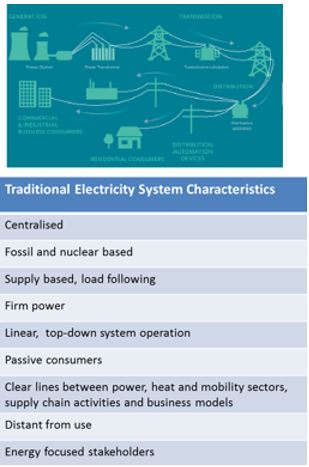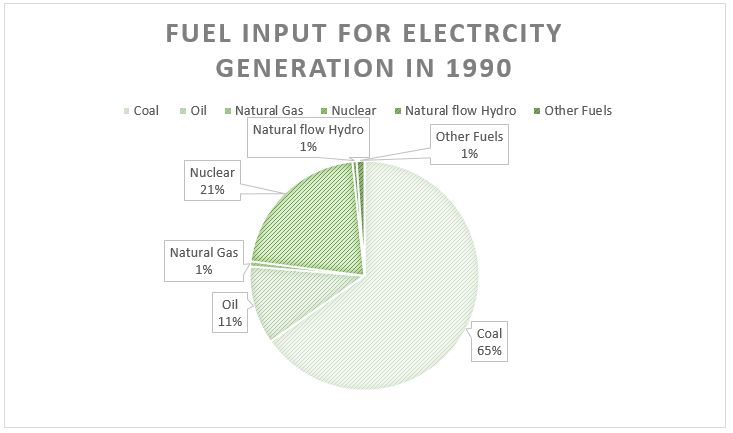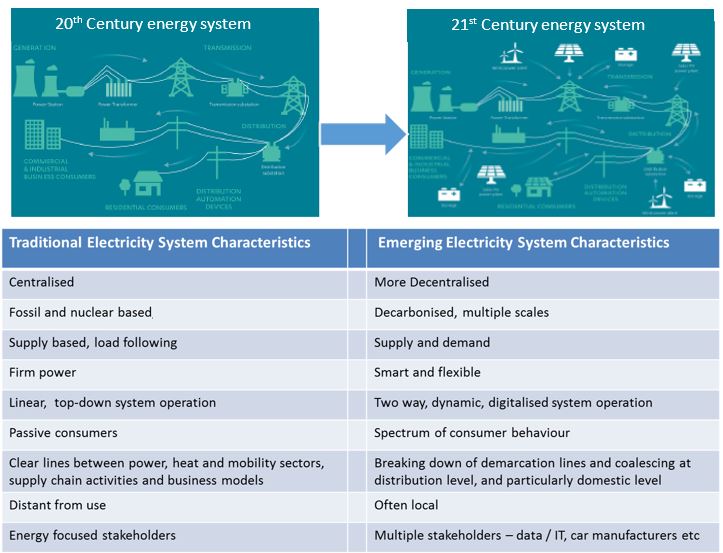Blog 1 Electricity Market Design Issues for a smart, flexible, sustainable and secure energy system: Setting the Scene
By Thomas Pownall
23rd July 2019
Many countries have increased their renewable energy generation over the last few decades. This is a great achievement to date, but simply adding capacity is not enough to achieve a more sustainable energy system. The governance of many aspects of our energy system needs to be reconsidered, including placing the consumer at the heart of the energy system.
This blog series is centred on electricity market design, rules and incentives. It is in four parts:
- Setting the scene in this blog
- Analysing the current electricity market design to see whether it is fit for a high renewable and energy efficient energy system
- Discussing the wider institutional glue which links the market design and networks
- Putting forward a proposed electricity market design
What are markets and market design?
In general, a market can be considered as a socially constructed interface where exchanges between relevant parties occur and can be repeated with the specifics of the trade determined by the market design: formal and informal rules which in turn provide the stability for all parties involved [1]. These social constructs are a space which is characterised by confrontation of parties and power struggles between these players [2].
The sale of electricity has a number of characteristics which need to be taken into account when designing an electricity market:
- The supply of electricity and its demand need to be in constant synchronisation.
- Electricity cannot be stored in the wires
- The flow of electricity is bound by the physical network infrastructure i.e. transformers, and therefore if a section of the network is congested then some electricity has to be spilled – the rules of doing so have economic consequences
- The introduction of new forms of technology such as variable renewable, storage and Demand-Side Response (DSR) bring in new resource characteristics and economics
- Electricity is vital to modern day society. Therefore the electricity market, is subjected to various governmental policies above the exchange of money for electricity with the goal of ensuring the UK has electricity when needed.
Current electricity market design
In order to ensure that electricity supply and demand are in constant synchronisation, each day is split into half hour segments called ‘Settlement Periods’. The UK wholesale market operates a bilateral trading system in which generators and resource providers strike up contracts determining how much electricity is required in any half hour.
However, at times when supply and demand are forecasted to deviate there is a balancing market in order to ensure any forecasted deviations are rectified i.e. parties contract to buy or sell electricity to become in balance. The parties responsible for these deviations are charged with the cost of ‘imbalance’ they have caused.
For a more in-depth explanation of this, please visit Elexon’s guidance page.
How has the electricity market design evolved?
The current electricity market design within the UK is a reflection of the historic system which was present when the electricity markets were introduced in 1990, alongside privatisation of the energy system. To understand why our electricity market design was designed as it is, we need to first consider the situation that was present at that time. The Figures below illustrate the landscape of the energy system at this time:

Figure 1: An overview of the traditional electricity system

Figure 2: Fuel input for electricity generation in 1990. Data Sourced from: https://www.gov.uk/government/statistical-data-sets/historical-electricity-data
In 1990 there was a top-down, centralised fossil fuel intensive energy system in the UK. Therefore when the new electricity market design was introduced in 1990 there emerged a rationale for it to be designed around these characteristics. You can see how these were reflected within the electricity market design:
- Centralised wholesale electricity market: at the time there were mainly large generators.
- Long term bilateral contracts: the generation fleet’s output was predictable and dependent on a quantifiable fuel source and could be forecasted well in advance.
The changing energy paradigm
Faced with the challenge of decarbonisation in an effort to meet emission targets the UK, like many other countries across the globe, have introduced measures to reduce their GHG emissions such as subsidies for renewable generation, energy efficiency targets and R&D into new technologies. This had led to a large increase in the deployment of new technologies such as solar PV and offshore wind farms.
However, as importantly, the technologies which operate the system have also changed, allowing new ways for operating the system, and this in turn alters the resources offered; the economics of the electricity system; and the economics of the wider energy system.

Figure 3: A comparison between the characteristics of the 20th century electricity system and the 21st
Despite these changing technologies and costs, electricity market design and wider regulatory changes are lagging behind these changes. This is reducing the UK’s ability to fully transition to a more efficient energy system with higher renewable generation. Current market design ultimately decides the winners and losers by determining what has access to them, according to the ‘old’ rules. These rules determine the winners. What is needed is a new market design which enables revenue streams to these new technologies and services. The latter add value to the new ways of operating the system but which currently cannot capture that value, or their full value, under the ‘old’ rules. Those companies which do have bilateral access (traditional generators) can access revenue streams; build investor confidence; and secure finance for new projects, whereas the new, smaller resource providers find it harder to secure revenue stream.
Blog 1 summary
In this first blog we have explored the impact of electricity market designs. We have also examined how electricity markets offer historic insights into our energy system. All of this is set against a changing energy paradigm and therefore the question the next blog will answer: is this current electricity market design fit for purpose?
References:
[1] Fligstein N, Calder R. Architecture of Markets. 2015.
[2] Caliskan K, Callon M. Economization, part 2: a research programme for the study of markets. Econ Soc 2010;39:1–32.
Related Posts
« Previous MOOC: Reflections on Energy Governance for Rapid Decarbonisation Electricity Market Design 2: the ‘rules of the game’ and why they no longer work Next »







